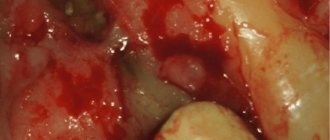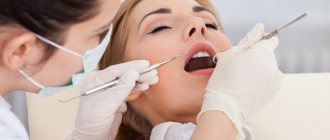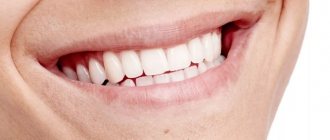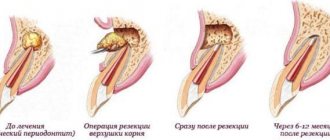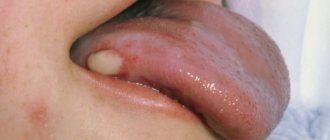Fused teeth are one of the rarest anomalies in the development of the dental-jaw system, which consists in connecting the sides of the rudiments during the development of the embryo. It occurs in only 1% of Patients.
Most often, fused teeth are observed during a primary dentition; with a permanent dentition, such an anomaly is extremely rare.
The reasons for the formation of fused teeth can be:
- hereditary factor;
- too much pressure on the buds of neighboring teeth;
- jaw injuries;
- inflammatory and infectious diseases that cause metabolic disorders in the human body.
Often, the fusion of teeth is confused with their fusion, although these pathologies are completely different in nature. Teeth fusion occurs during the period after their growth and development, and fusion occurs during the formation of tooth buds.
What is ankylosis
Tooth ankylosis is a pathology characterized by fusion of the cement of the tooth with the jaw bone. The tooth root is deprived of part of the ligamentous apparatus, which often leads to adhesion or germination of bone tissue. The aesthetics of the teeth are disrupted, they look shorter and change their angle. Ankylosis usually occurs during tooth eruption. Pathology can also form at a late stage in the formation of the dental arch.
It is important to know. The process is accompanied by periodontal necrosis and the incorporation of root cement into the alveolar bone.
Ankylosis of a primary tooth is caused by loss of the periodontal ligament. It is observed in cases where a primary molar does not fall out due to the absence of a permanent dental unit. Ankylosed teeth are different in size from their neighbors, so bite correction will be required.
Correction methods
Several decades ago, a person with such an anomaly had two options: remove the merged specimens, or walk with them all his life, building up an inferiority complex.
Today, dentists, using modern techniques and materials, can successfully correct this problem while the main tooth remains intact.
What problems need to be solved?
When choosing a treatment method for this anomaly, the doctor is primarily guided by the tasks that must be solved through therapy.
The main tasks include:
- Correction of pathology while preserving the more significant half.
- Freeing up the necessary space to correct its position.
- Creating favorable conditions for the formation of normal occlusion and dentition.
- Preservation of the pulp chamber and the pulp of the main half to extend the life of the tooth.
What determines the choice of method?
Unlike the treatment of other dental anomalies, in which the fundamental factor in choosing a method is the patient’s age, in this case they rely only on the degree of pathology :
- To eliminate the problem in the first degree of anomaly, they resort to gentle treatment, which involves grinding off the adjacent part.
This method allows you to completely preserve the main one, without the use of additional equipment and special filling materials, since the affected units do not have a common pulp chamber.If necessary, the procedure ends with restoration.
- For the second type hemiresection , in which the supernumerary part is disconnected and removed. In this case, periodontal tissues are not injured.
- With the third type of anomaly, hemisection , which involves exfoliation of the gum tissue and dissection of the root part.
- Treatment for the fourth degree is prescribed exactly the same as for the third, but the dissection is carried out along the entire length .
Sequence of procedure
The treatment takes place in several stages, the first of which involves the immediate removal of the secondary part.
If it is necessary to carry out removal with dissection of only the upper part, then conduction anesthesia is used. In case of complete dissection, general anesthesia may be administered.
Depending on the technique, the main points of the procedure may differ.
Hemiresection involves several steps:
- The dentist uses a diamond disc to cut off a smaller portion of the tooth.
- Performs extraction by rupturing the periodontal ligaments and dislocation.
- Grinding the cut areas with constant irrigation with an aseptic preparation.
- Washing the wound and applying a medicinal application with biologically active components that restore damaged tissue. The bandage is fixed for 2 weeks, after which it is removed.
How to recognize macrodentia, characteristic signs and treatment methods.
In this material we will look at why wisdom teeth are characterized by manifestations of dystopia.
Here https://orto-info.ru/zubocheliustnye-anomalii/zubov/polozheniya/krivyie.html you will see in the photo how effective the fixation of veneers is on crooked teeth.
Hemisection , which is a more traumatic operation, proceeds as follows :
- To gain access to the root part of the tooth, the dentist performs an excision of soft tissue by making an angular incision on the vestibular side of the jaw, plunging the scalpel all the way to the alveolar bone.
In order for the excised tissue to move to the side without any problems, it is cut on both sides of the problem tooth and at its cervical part.The result is a trapezoidal flap that is easily separated from the jawbone.
- It is then peeled off, exposing the cortical bone, from which a limited area is removed. This allows access to the roots.
- Using a special fissure-type bur and diamond discs, the root and then the crown part of the tooth are cut off. The cut off parts are removed.
- The disconnection site is polished, while the wound is constantly treated with saline solution, which ensures the safety of the main part of the pulp left in the alveolar arch.
- The cleaned area is covered with a special composite that restores the tooth wall.
- The mucosal and periosteal flaps are placed in place and sutured with simple surgical sutures, which are removed after 7 days.
- Next, the tooth is splinted for 2 weeks.
2 weeks after removal of the complementary half, the second stage of treatment begins - orthodontic. This type of treatment allows you to completely restore the normal position of your teeth and correct your bite.
Most often, braces with arches of varying degrees of rigidity are used for this, regular replacement of which leads to complete restoration of the row after 8–15 months .
To prevent the tooth from returning to its previous position after correction, retainers are additionally prescribed. The retention period, as a rule, lasts almost as long as the main treatment.
How to remove a tooth with root separation, watch the video:
Symptoms
Parents should be wary of the fact that their child’s baby teeth are not falling out. It is fused to the bone and cannot easily separate from the alveoli, as is normal. If the pathology is not detected and treated in a timely manner, the child’s jaw begins to develop incorrectly. The diseased tooth is located lower than the others, and the neighboring teeth are placed at an angle in relation to it. Problems with bite occur.
Another scenario is also possible. The baby tooth does not erupt completely and is delayed in its development. Because of this, the permanent tooth also cannot develop, and after the milk tooth falls out, it becomes fused with the jaw. This is how ankylosis of permanent teeth occurs. The final diagnosis is made after analyzing the results of a computed tomography scan.
Good to know. The service life of ankylosed teeth is completely different. They can last for decades or fall out, thinning out the dentition.
Consequences of dental fusion
The fusion of teeth is one of the forms of their incorrect development, which should not be taken lightly, as it can negatively affect the functioning of the entire dentofacial system.
The consequences of dental fusion can be:
- formation of abnormal occlusion;
- severe difficulty biting and chewing food;
- predominant mouth breathing, and, as a result, ENT diseases;
- diction disorders: lisp, unclear pronunciation of certain sounds, swallowing of words;
- psychological discomfort.
Treatment of ankylosis
Treatment of ankylosis with traditional orthodontic methods (braces) is impossible. The tooth grows into the bone and it is impossible to return it to its correct position. But restoring the functionality of the dentition is quite possible. In dental clinics, the method of treatment is selected individually in each individual case.
First of all, the patient is referred for a dental computed tomography scan. The dental surgeon studies panoramic images and draws up a treatment plan. Most often, surgical treatment methods are used: excess fibrous tissue is removed and joint mobility is restored. Crowns made of metal-ceramics, ceramics and zirconium dioxide are also used to treat dental ankylosis. With their help, the bite is corrected.
Types of Teeth Fusion
In orthodontics, there are several types of dental fusion:
- first: supernumerary fusion. In this case, the second tooth is much smaller than the first. It is characterized by a spiky shape and a bumpy surface;
- second: non-gingival, observed only in the supragingival part involving a certain area of enamel;
- third type: root. Occurs in the root part at the level of cement and is characterized by deep damage to dentin. At the same time, both teeth have the same size;
- fourth: observed along the entire height of the tooth with damage to the crown and root parts.
How to make teething easier? Some tips:
- To prevent the child from gnawing on everything, there are special rubber rings, as well as toys made of silicone and toys with filler, the latter must first be cooled. If you don’t have anything at hand, you can give your child a cooled terry cloth. Items should be cooled in the refrigerator, but not in the freezer.
- In cases of fever, medications containing paracetamol are given, but only after consulting a doctor. It is strictly forbidden to give your baby aspirin, analgin or apply tablets to the gums.
- A compress with chamomile or oak bark decoctions will ease the itching. Under no circumstances should you use alcohol-containing preparations for compresses.
- Massage your gums. Usually, pain-relieving gels are used for this; massage with oils (chamomile, clove), honey or pieces of ice wrapped in cotton cloth is possible.
- Just play. Distract your child more often, talk to him, look at pictures, take a walk. Then teething will be much easier, not only for the baby, but also for everyone around him.
Ishchenko Elena Nikolaevna Dentist-therapist for children. Professional in the field of pediatric dentistry.
Show more tips
How do you know when teeth have started to erupt?
If your baby's gums are red and swollen, it means the first tooth will appear soon. To be sure that discomfort in the gums is not associated with any diseases, you can try to “tap” the future tooth (you can already feel it a few days before it appears).
The appearance of teeth is inextricably linked with increased salivation and itching of the gums. At this time, you need to watch your child especially carefully, as he puts everything in his mouth, from toys to bed bars.
As I said earlier, symptoms of teething sometimes include fever and loss of appetite. In this case, with weakened immunity, infectious diseases may develop.
Make an appointment
Surgery to remove wisdom teeth
When deciding to remove the rudiments of the third molars, it is necessary to take into account all the individual periods of growth and formation of the bones of the facial skeleton. In our Kuntsevo we have all the necessary conditions for painless and quick removal of third molar buds in adolescents.
The work can be divided into main stages:
- safe and deep pain relief;
- opening access to the tooth germ;
- painless extraction of wisdom tooth buds using professional instruments;
- antiseptic treatment and wound dressing.
The entire procedure lasts 40-60 minutes and may include the removal of all four tooth buds. Thanks to our low-traumatic technique, the recovery period passes quite quickly. For several days, you must follow all the doctor’s instructions, after which a specialist will monitor the healing of the tissue.
Kuntsevo is equipped with the most modern equipment and instruments, which allows you to remove wisdom teeth without the use of forceps. We have ample opportunities for all diagnostic studies and comfortable dental operations of any level of complexity.
